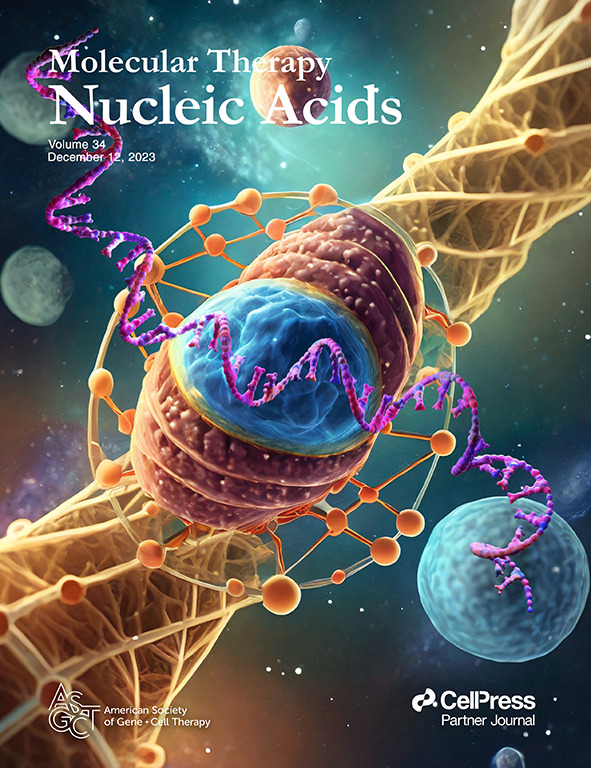Simple improvements in vector design afford substantial gains in AAV delivery of aggregation-slowing Aβ variants
IF 6.5
2区 医学
Q1 MEDICINE, RESEARCH & EXPERIMENTAL
引用次数: 0
Abstract
Adeno-associated virus (AAV) gene therapy for neurological disease has gained traction due to stunning advances in capsid evolution for CNS targeting. With AAV brain delivery now in focus, conventional improvements in viral expression vectors offer a complementary route for optimizing gene delivery. We previously introduced a novel AAV gene therapy to slow amyloid aggregation in the brain based on neuronal release of an Aβ sequence variant that inhibited fibrilization of wild-type Aβ. Here we explore three coding elements of the virally delivered DNA plasmid in an effort to maximize the production of therapeutic peptide in the brain. We demonstrate that simply replacing the Gaussia luciferase signal peptide with the mouse immunoglobulin heavy chain signal peptide increased release of variant Aβ by ∼5-fold. Sequence modifications within the expressed minigene further increased peptide release by promoting γ-secretase cleavage. Addition of a cytosolic fusion tag compatible with γ-secretase interaction allowed viral transduction to be tracked by immunostaining, independent from the variant Aβ peptide. Collectively these construct modifications increased neuronal production of therapeutic peptide by 10-fold upon intracranial AAV injection of neonatal mice. These findings demonstrate that modest changes in expression vector design can yield substantial gains in AAV efficiency for therapeutic applications.载体设计的简单改进就能大幅提高 AAV 释放聚集减缓型 Aβ 变体的能力
用于神经系统疾病的腺相关病毒(AAV)基因疗法由于在中枢神经系统靶向的囊膜进化方面取得了惊人的进展而备受关注。随着 AAV 脑部递送成为焦点,病毒表达载体的传统改进为优化基因递送提供了一条补充途径。我们之前介绍了一种新型 AAV 基因疗法,这种疗法基于神经元释放的 Aβ 序列变体抑制野生型 Aβ 的纤维化,从而减缓淀粉样蛋白在大脑中的聚集。在这里,我们探讨了病毒递送 DNA 质粒的三个编码元素,以最大限度地提高治疗肽在大脑中的产量。我们证明,只需用小鼠免疫球蛋白重链信号肽替换高斯荧光素酶信号肽,变体Aβ的释放量就会增加5倍。通过促进γ-分泌酶的裂解,表达的迷你基因中的序列修饰进一步增加了肽的释放。加入与γ-分泌酶相互作用相容的细胞质融合标签后,病毒转导可通过免疫染色进行追踪,而不受变体 Aβ 肽的影响。在新生小鼠颅内注射 AAV 后,这些构建修饰可使神经元产生的治疗肽增加 10 倍。这些研究结果表明,表达载体设计的适度改变可以大大提高 AAV 的治疗效率。
本文章由计算机程序翻译,如有差异,请以英文原文为准。
求助全文
约1分钟内获得全文
求助全文
来源期刊

Molecular Therapy. Nucleic Acids
MEDICINE, RESEARCH & EXPERIMENTAL-
CiteScore
15.40
自引率
1.10%
发文量
336
审稿时长
20 weeks
期刊介绍:
Molecular Therapy Nucleic Acids is an international, open-access journal that publishes high-quality research in nucleic-acid-based therapeutics to treat and correct genetic and acquired diseases. It is the official journal of the American Society of Gene & Cell Therapy and is built upon the success of Molecular Therapy. The journal focuses on gene- and oligonucleotide-based therapies and publishes peer-reviewed research, reviews, and commentaries. Its impact factor for 2022 is 8.8. The subject areas covered include the development of therapeutics based on nucleic acids and their derivatives, vector development for RNA-based therapeutics delivery, utilization of gene-modifying agents like Zn finger nucleases and triplex-forming oligonucleotides, pre-clinical target validation, safety and efficacy studies, and clinical trials.
 求助内容:
求助内容: 应助结果提醒方式:
应助结果提醒方式:


